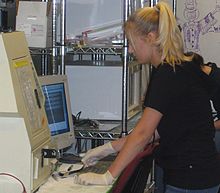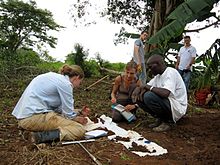Agronomy: Difference between revisions
| Line 26: | Line 26: | ||
In addition, agronomists develop methods to preserve the soil and to decrease the effects of [[erosion]] by wind and water. For example, a technique called [[contour plowing]] may be used to prevent soil erosion and conserve rainfall. Researchers in agronomy also seek ways to use the soil more effectively in solving other problems. Such problems include the disposal of human and animal wastes; [[water pollution]]; and the build-up in the soil of chemicals called [[pesticide]]s, which are used to kill insects and other pests. No-tilling crops is a technique now used to help prevent erosion. |
In addition, agronomists develop methods to preserve the soil and to decrease the effects of [[erosion]] by wind and water. For example, a technique called [[contour plowing]] may be used to prevent soil erosion and conserve rainfall. Researchers in agronomy also seek ways to use the soil more effectively in solving other problems. Such problems include the disposal of human and animal wastes; [[water pollution]]; and the build-up in the soil of chemicals called [[pesticide]]s, which are used to kill insects and other pests. No-tilling crops is a technique now used to help prevent erosion. |
||
planting of soil binding grasses along contours can be tried in steep slopes. For better effect, contour drains of depths up to 1 metre may help retain the soil and prevent permanent wash off. |
planting of soil binding grasses along contours can be tried in steep slopes. For better effect, contour drains of depths up to 1 metre may help retain the soil and prevent permanent wash off. |
||
Mr. o is dumbass |
|||
==Agroecology== |
==Agroecology== |
||
Revision as of 18:22, 28 August 2008
Agronomy is the science and technology of utilizing plants for food, fuel, feed, and fiber. Agronomy encompasses work in the areas of plant genetics, plant physiology, meteorology, and soil science.[1] Agronomy is the application of a combination of sciences like biology, chemistry, ecology, earth science, and genetics. Agronomists today are involved with many issues including producing food, creating healthier food, managing environmental impacts, and creating energy from plants.[2] Agronomists often specialize in areas such as crop rotation, irrigation and drainage, plant breeding, soil classification, soil fertility, weed control, insect and pest control and other areas.

Plant Breeding
This area of high demand in Agronomy involves selective breeding of plants to produce the best crops under various conditions. Plant breeding has increased crop yields and has improved the nutritional value of several crops, including corn, soybeans, and wheat. It also has led to the development of new types of plants. For example, a hybrid grain called triticale was produced by crossbreeding rye and wheat. Triticale contains more usable protein than does either rye or wheat. Agronomy has also been instrumental in fruit and vegetable production research. It is understood that the role of Agronomist includes seeing whether produce from a field satisfies the following conditions: 1. Land and water access, 2. Commencialisation (market), 3. Quality and Quantity of inputs, 4. Risk protection (insurance), 5. Agricultural credit.
Biotechnology

Agronomists use biotechnology to extend and expedite the development of desired characteristics listed in the Plant Breeding section.[3] Biotechnology is is often a lab activity requiring field testing of the new crop varieties that are developed.
In addition to increasing crop yields, reducing crop vulnerability to environmental stresses, improving health and taste of foods, and reducing the need for field applied chemicals, agronomic biotechnology is increasingly being applied for novel uses other than food. For example, oilseed is at present used mainly for margarine and other food oils, but it can be modified to produce fatty acids for detergents, substitute fuels and petrochemicals.[4] you are all right
Soil Science

Agronomists study sustainable ways to make soils more productive. They classify soils and reproduce them to determine whether they contain substances vital to plant growth. Such nutritional substances include compounds of nitrogen, phosphorus, and potassium. If a certain soil is deficient in these substances, fertilizers may provide them. Agronomists investigate the movement of nutrients through the soil, and the amount of nutrients absorbed by a plant's roots. Agronomists also examine the development of the roots and their relation to the soil.
Soil Conservation
In addition, agronomists develop methods to preserve the soil and to decrease the effects of erosion by wind and water. For example, a technique called contour plowing may be used to prevent soil erosion and conserve rainfall. Researchers in agronomy also seek ways to use the soil more effectively in solving other problems. Such problems include the disposal of human and animal wastes; water pollution; and the build-up in the soil of chemicals called pesticides, which are used to kill insects and other pests. No-tilling crops is a technique now used to help prevent erosion. planting of soil binding grasses along contours can be tried in steep slopes. For better effect, contour drains of depths up to 1 metre may help retain the soil and prevent permanent wash off. Mr. o is dumbass
Agroecology
Agroecology is the management of agricultural systems with a strong emphasis on ecological and environmental perspectives.[5] This area is closely associated with work in the areas of Sustainable Agriculture, Organic agriculture, and the development of alternative cropping systems.
Theoretical modelling
See Theoretical production ecology
Agronomy Schools
Higher education is currently a common denominator for agronomist. Programs and classes are typically found in several departments depending on the school; agronomy covers topics in agriculture, biology, chemistry, and physiology.
Career Outlook
Employment of Agronomists is expected to grow 9 percent between 2006 and 2016, about as fast as the average for all occupations. Past agricultural research has created higher yielding crops, crops with better resistance to pests and plant pathogens, and more effective fertilizers and pesticides. Research is still necessary, however, particularly as insects and diseases continue to adapt to pesticides and as soil fertility and water quality continue to need improvement.
Emerging biotechnologies will play an ever larger role in agricultural research. Scientists will be needed to apply these technologies to the creation of new food products and other advances. Moreover, increasing demand is expected for biofuels and other agricultural products used in industrial processes. Agricultural scientists will be needed to find ways to increase the output of crops used in these products.
Agronomists will also be needed to balance increased agricultural output with protection and preservation of soil, water, and ecosystems. They increasingly encourage the practice of sustainable agriculture by developing and implementing plans to manage pests, crops, soil fertility and erosion, and animal waste in ways that reduce the use of harmful chemicals and do little damage to farms and the natural environment.[6]
Most agronomists are consultants, researchers, or teachers. Many work for agricultural experiment stations, federal or state government agencies, industrial firms, or universities. Agronomists also serve in such international organizations as the Agency for International Development and the Food and Agriculture Organization of the United Nations.
See also
- Agriculture
- Agricultural economics
- Agricultural experiment station
- Agronomist
- List of Agronomy Journals
- Plant physiology
- Soybean management practices
References
- ^ http://en.wiktionary.org/wiki/agronomy
- ^ I'm An Agronomist!
- ^ Georgetown International Environmental Law Review: http://findarticles.com/p/articles/mi_qa3970/is_200004/ai_n8898629
- ^ http://en.wikipedia.org/wiki/Biotechnology#Production_of_novel_substances_in_crop_plants
- ^ Agroecology
- ^ Agricultural and Food Scientists
Further reading
- The Future World of Agriculture by Wendy B. Murphy, Watts, 1984.
- Storia delle scienze agrarie by Antonio Saltini, 4 vols, Bologna 1984-89, ISBN 88-206-2412-5, ISBN 88-206-2413-3, ISBN 88-206-2414-1, ISBN 88-206-2414-X
External links
- The American Society of Agronomy (ASA)
- European Society for Agronomy
- The World Food Prize
- The National Agricultural Library (NAL) – Comprehensive agricultural library.
